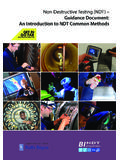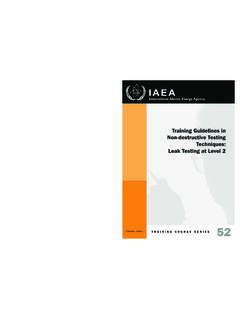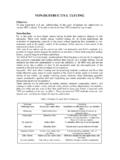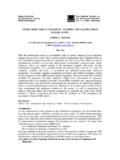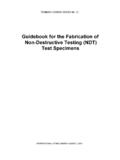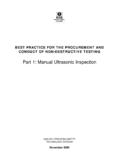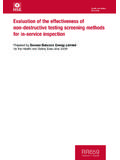Transcription of Non-Destructive Testing of Concrete: A Review of …
1 Special Issue: Electronic Journal of Structural Engineering 14(1) 2015 97 1 introduction Non-Destructive Testing (NDT) is defined as the course of inspecting, Testing , or evaluating materials, components or assemblies without destroying the serviceability of the part or system (Workman & O. Moore, 2012). The purpose of NDT is to determine the quality and integrity of materials, components or assemblies without affecting the ability to perform their intended functions. Non-destructiveness ought not to be confused with non-invasiveness. Testing methods that do not affect the future usefulness of a part or system are considered to be Non-Destructive even if they consist of invasive actions. For exam-ple, coring is a common NDT method that is em-ployed to extract and test specimens from concrete components in order to determine the properties of in-situ concrete.
2 Coring alters the appearance of the component and marginally affects its structural in-tegrity. If done correctly, coring maintains the ser-viceability of the structural component and is thus considered to be Non-Destructive . destructive Testing explores failure mechanisms to determine the mechanical properties of material such as yield strength, compressive strength, tensile strength, ductility and fracture toughness. NDT methods explore indications of properties without reaching component or assembly failures. Extensive attempts and advancements have been made to de-velop NDT methods capable of indicating mechani-cal, acoustical, chemical, electrical, magnetic, and physical properties of materials. One of the earliest documented attempts of NDT dates to the 19th cen-tury where cracks were detected in railroad wheels by means of acoustic tap Testing (Stanley, 1995).
3 More sensitive, reliable and quantifiable NDT meth-ods have expansively emerged in recent years. NDT methods have materialized as a response to the need for structural damage detection and preven-tion. The extensive use of NDT is driven by eco-nomics and safety. In a pre-emptive attempt to erad-icate the problems associated with structural deterioration, novel in-site Testing techniques have been invented to allow for the assessment of con-crete during the construction, commissioning and servicing lifecycle stages of a structure. The major factors that influence the success of a Non-Destructive survey are depth of penetration, ver-tical and lateral resolution, contrast in physical properties, signal-to-noise ratio and existing infor-mation about the structure (McCann & Forde, 2001).
4 The understanding of material properties and the key issues associated with their application in structural engineering is imperative for the success of any NDT method. The steps to choosing an adequate NDT method are (Shull, 2002): Understanding the physical nature of the material property or discontinuity to be inspected; Understanding the underlying physical processes that govern the NDT method; Non-Destructive Testing of Concrete: A Review of Methods J. Helal, M. Sofi, P. Mendis. University of Melbourne, Australia Email: ABSTRACT: This paper reviews the most common Non-Destructive Testing (NDT) methods of concrete struc-tures as utilized by the structural engineering industry. The fundamentals of NDT methods are explored in re-gards to their potential, limitations, inspection techniques and interpretations.
5 The factors that influence the success of NDT methods are discussed and ways to mediate their influence are recommended. Reference is made to standard guidelines for the application and interpretation of the discussed NDT methods. NDT of concrete was found to be gaining increasing acceptance as a means of evaluating the strength, uniformity, du-rability and other properties of existing concrete structures. Perceptions of NDT inadequacy were attributable to lack of understanding construction materials and NDT methods themselves. The intent of this paper is to address these concerns by identifying and describing the most common successful methods of NDT as ap-plied to concrete structures. Special Issue: Electronic Journal of Structural Engineering 14(1) 2015 98 Understanding the physical nature of the interac-tion of the probing field with the test material Understanding the potential limitations of availa-ble NDT technology; Considering economic, environmental, regulatory and other factors.
6 There is a wide range of NDT methods which are used by the civil and structural engineering industry. While there appears to be ample technical literature regarding NDT of concrete, there is a lack of collab-oration between civil engineers, NDT researchers and specialists. The intent of this paper is to bridge the gap by identifying and describing the most common methods of NDT as applied to concrete structures. 2 Non-Destructive TESTNG METHODS Surface hardness methods Non-Destructive surface hardness methods are non-invasive procedures that investigate strength charac-teristics of material. The two categories that define concrete surface hardness techniques are indentation methods and rebound methods. These methods at-tempt to exploit empirical correlations between strength properties of concrete and surface hardness as measured by indentation or rebound.
7 Originating in the 1930 (Jones, 1969), indentations methods are no longer common in the civil engineering industry, whereas rebound methods are frequently applied to investigate concrete strength characteristics with reference to standard guidelines on Testing and inter-pretation. The most commonly used surface hardness pro-cedure is the standard rebound hammer test. The test was developed in 1948 by Swiss engineer Ernst Schmidt and is commonly referred to as the Schmidt Rebound Hammer (Kolek, 1969). Upon impact with the concrete surface, the rebounded hammer records a rebound number which presents an indication of strength properties by referencing established em-pirical correlations between strength properties of concrete (compressive and flexural) and the rebound number.
8 The fundamental understanding of impact and re-bound relates to the theory of wave propagation. A compression wave is propagated when the surface of the concrete is disturbed by the plunger ( i). The re-action force propagates a reflected compression wave through the plunger ( r). The ratio of the wave amplitudes ( r/ i) is found to be proportional to the rebound number which could be empirically corre-lated to compressive and flexural strength (Akashi & Amasaki, 1984). Operation of the Standard Rebound Hammer re-quires less mechanical skills as compared to other methods of NDT. A visual examination of the con-crete surface should be conducted prior to the test in order to identify a smooth surface suitable for test-ing. The test can be conducted in any directional an-gle where calibration charts are used to mitigate the different effects of gravity (Fig.)
9 1). The hammer is pressed against the concrete surface until a spring loaded mass is released causing the plunger to im-pact against the surface and rebound a distanced measured by a slide indicator (Fig. 2). The meas-ured distance is referred to as the rebound number. Figure 1. NDT of concrete by Schmidt Rebound Hammer (As adapted from ) Figure 2. Schematic diagram of Schmidt rebound hammer pro-cedure (Malhotra, 2004) Empirical correlations are provided by the manu-facturer to relate the rebound number to concrete strength properties; however, the Testing conditions of the manufacturer might be dissimilar to the condi-tions present. Therefore, it is recommended to con-duct a test-specific correlation procedure where a number of concrete cylinders ranging in strength are Special Issue: Electronic Journal of Structural Engineering 14(1) 2015 99 prepared and tested by both Standard Rebound Hammer and compression- Testing machine.
10 The re-sults of the two tests are then integrated into a sim-ple regression analysis model which yields an em-pirical correlation by means of ordinary least squares. The following publications present standard guidelines for the application and interpretation that govern the standard rebound test: ASTM C 805: Standard Test Method for Re-bound Number of Hardened Concrete; BS EN 12504-2:2012: Testing Concrete in Struc-tures - Non-Destructive Testing - Determination of Rebound Number. The Standard Rebound Hammer provides a sim-ple, easy and inexpensive method to estimate con-crete strength properties. However, the results of the test on concrete are affected by various factors such as smoothness of the surface, geometric properties of the test specimen, age of the test specimen, sur-face and internal moisture conditions of the con-crete, type of coarse aggregate, type of cement, type of mold and carbonation of the concrete surface (Malhotra, 2004).






